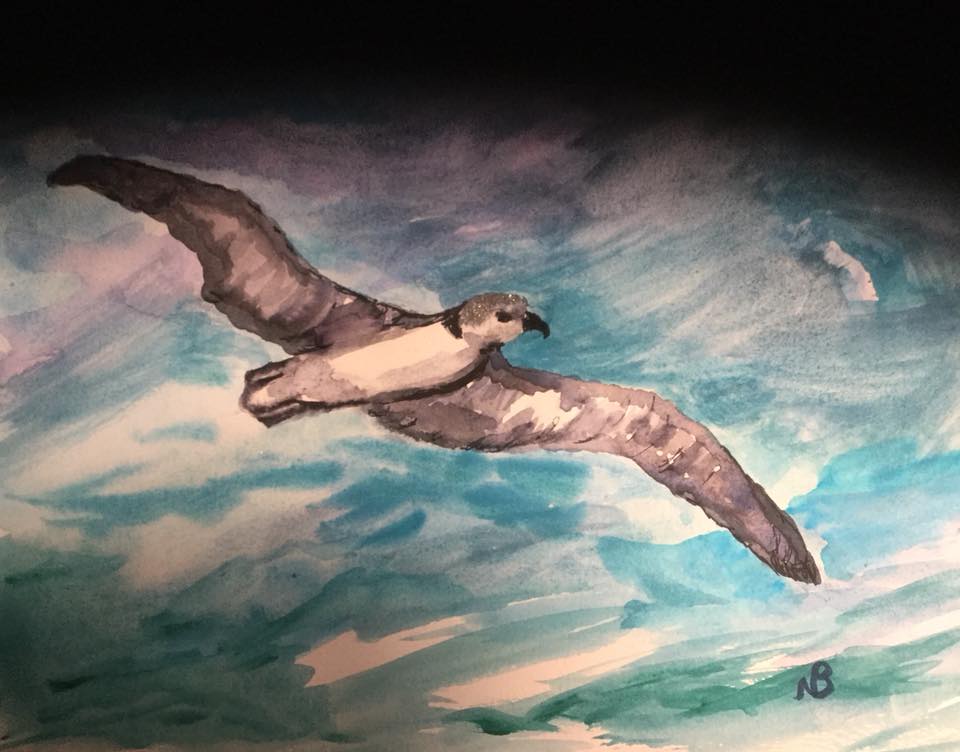
Grey-headed Albatross, artwork by Nancy Bryant for ACAP, after a photogaph by Dimas Gianuca
Caitlin Frankish (British Antarctic Survey, Cambridge, UK) and colleagues have published in the journal Biological Conservation on tracking juvenile Grey-headed Albatrosses Thalassarche chrysostoma (globally Endangered). The study will help inform ACAP’s Seabird Working Group in its deliberations, currently taking place virtually at its Tenth Meeting.
The paper’s abstract follows:
“Fisheries bycatch is a major threat to marine megafauna such as seabirds. Population monitoring has revealed low survival of juvenile seabirds over recent decades, potentially because naïve individuals are more susceptible to bycatch than adults. However, major gaps remain in our knowledge of behavior and interaction of juveniles with fisheries. Here, we tracked juvenile grey-headed albatrosses (Thalassarche chrysostoma) from South Georgia - the largest global population of this endangered species, and in rapid decline - to investigate their at-sea distribution and assess bycatch risk. Fledged juveniles dispersed to the northeast, overlapping with a bycatch hotspot for grey-headed albatrosses reported by the Japanese pelagic longline fleet in the southeast Atlantic Ocean. Given adult grey-headed albatrosses use regions less exposed to fishing activity (< 40°S), the majority of birds bycaught in this area are probably juveniles, and possibly immatures, from South Georgia, likely representing a key factor explaining the sustained population decline. Our study highlights the urgent need to uncover the ‘lost-years’ for marine megafauna to enable focused conservation efforts.”
The British Antarctic Survey writes on its Facebook page about the publication:
"Tracking juvenile seabirds confirms a new fisheries-bycatch hotspot for endangered albatross population – New research led by ecologist Dr Caitlin Frankish shows that juvenile grey-headed albatrosses tracked from South Georgia [Islas Georgias del Sur]* disperse to a region in the southeast Atlantic where the Japanese pelagic longline fishing fleet has reported a high number of bycaught (unintentionally caught) individuals of the same species. Caitlin says, “As this region isn’t used by adults, this finding suggests that these bycaught birds are likely juveniles from South Georgia, which may be a key factor in explaining the continued decline in their population size. This study highlights the importance of uncovering the distribution of albatrosses of all ages and has important implications for focusing future conservation efforts.” Learn more about the Grey-headed Albatross Juvenile Tracking project here."
With thanks to Richard Phillips, Brirish Antarctic Survey
Reference:
Frankish, C.K., Cunningham, C., Manica, A., Clay, T.A., Prince, S. & Phillips, R.A. 2021. Tracking juveniles confirms fisheries-bycatch hotspot for an endangered albatross. Biological Conservation 261. doi.org/10.1016/j.biocon.2021.109288.
John Cooper, ACAP Information Officer, 18 August 2021
*A dispute exists between the Governments of Argentina and the United Kingdom of Great Britain and Northern Ireland concerning sovereignty over the Falkland Islands (Islas Malvinas), South Georgia and the South Sandwich Islands (Islas Georgias del Sur y Islas Sandwich del Sur) and the surrounding maritime areas.

 English
English  Français
Français  Español
Español